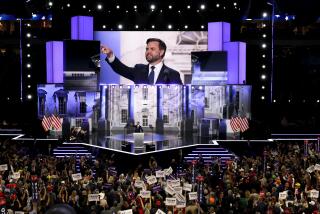RICHARD NIXON: 1913-1994 : Reporter Recalls Seeing Nixon Take a Trip Down Memory Lane : Media: A Pasadena newsman interviewed former President in 1980 as he was bidding a nostalgic farewell to his old congressional district.
It was an opportunity not to be missed.
I was a 23-year-old reporter for the Pasadena (Calif.) Star-News when a restaurant bartender phoned in a tip to the newsroom:
Richard Nixon, the Richard Nixon, was at the restaurant, in the city of San Gabriel, having lunch.
In those days I was what passed for the paperâs politics reporter. And Nixon, who had resigned the presidency 5 1/2 years earlier, was nearly a recluse at his San Clemente estate. He had not granted an interview in years to a newspaper reporter, a couple of whom had unearthed the scandal that drove him from office.
I sprinted out of the newsroom with one certainty in mind--Richard M. Nixon would not leave that restaurant before I reached him.
Fortunately for me, the afternoon of Jan. 31, 1980, was not a time of high alert for the usually vigilant police forces of Pasadena, South Pasadena, San Marino or San Gabriel. I remember approaching 90 m.p.h. on the downhill grade of Atlantic Boulevard--with not a radar gun in sight.
Pulling to within a block or so of the restaurant, I noticed a shiny recreational vehicle, led and followed by two sedans with antennas sticking everywhere.
This had to be Nixon. And he was leaving! Heading for a freeway, I figured. Back to the seclusion of San Clemente, no doubt.
Out of curiosity, I joined the ersatz motorcade; after just a few short blocks, the procession pulled into the historic San Gabriel Mission.
I parked and walked toward the front of the building, where the RV was stopped. A Secret Service agent intercepted and questioned me. He spoke into his two-way radio. I was surprised when the word came back: Nixon would see me.
I met him just inside the foyer. He stood in his gray suit, jacket buttoned, presidential pin on the lapel, relaxed yet formal. He appeared, for lack of a more fitting description, presidential. With him were at least four aides, including Raymond Price, his former presidential speech writer.
We shook hands and began with some small talk, which took on the tone of a trivia challenge. When I told Nixon what paper I represented, he thought for a moment and blurted out, â Ridders! â the family that then still partly owned the publication.
âWhat college did you go to?â Nixon next wanted to know. âSan Jose State,â I said. Instantly, he shot back, â Spartans ! Good football team!â
I asked Nixon what he was doing in the San Gabriel Valley. He said that he was touring parts of his old congressional district, the one he represented from 1946 to 1950, making a nostalgic farewell. The next week, on Feb. 9, 1980, Nixon would leave California and relocate to New York, where he would work nonstop to refurbish his image.
Tourists at the mission began bunching around us, taking pictures. (A few weeks later one of them, a retired lawyer from Skokie, Ill., sent me a color slide. It shows a smiling, rather comfortable Nixon with his arm around the shoulders of an expressionless 23-year-old journalist, sans coat or tape recorder.)
All of which underscored what I saw as the oddity of our encounter. Nixon told me that, before lunch, he had visited the auditorium at South Pasadena High School, âwhere I had my first debate.â
I informed him that my parents had attended that debate. This excited him. âYour mother was at my debate?â he asked. Immediately he turned to Price. âRay,â he said, âget me a pen. . . . Whatâs your motherâs name?â On the spot, Nixon signed an unsolicited autograph to my mother.
What I didnât tell Nixon, what I couldnât put in my article 14 years ago, was that my mother was no admirer of Richard Nixon. I was raised in a household that was, to say the least, absolutely anti-Nixon.
Before Cambodia, Kent State or Watergate, I grew up hearing over and again how Nixon had viciously snuffed the career of five-term Democratic Rep. Jerry Voorhis, by all accounts a decent man with a liberal voting record. Of how Nixon unfairly linked Voorhisâ support for subsidized milk for poor schoolchildren to socialism. Of how, four years after winning election to the House, Nixon similarly attacked incumbent Democrat Helen Gahagan Douglas to win a seat in the U.S. Senate.
I asked Nixon that day whether he would try to contact Voorhis, who at the time was still alive, a few miles away in Claremont. Based on Nixonâs surprised reaction, it clearly was a notion that had not crossed his mind.
Nixon would make some news that day in our half-hour interview. For the first time, he called the Soviet invasion of Afghanistan a âviolation of the precepts of international conduct.â He endorsed President Jimmy Carterâs announced intention to boycott the upcoming Olympic Games in Moscow, although he predicted that it would have little effect on the Russians. Regarding an expanded role for women in the American military, Nixon said: âI think the suggestion that women be registered and be drafted is ridiculous.â
Nixon told me that his latest book was about to be published and that he would be sure to send it to me. From the man regarded as historyâs ultimate anti-media President, this was quite a charm offensive.
And, sure enough, I arrived home three months later to find âThe Real Warâ on my doorstep, complete with a personal inscription from the 37th President of the United States.
More to Read
Sign up for Essential California
The most important California stories and recommendations in your inbox every morning.
You may occasionally receive promotional content from the Los Angeles Times.











